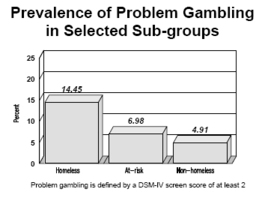If pathological gambling can wreak personal, social, and economic havoc on the average American who brings home $2038.40 in pre-tax income every four weeks [1], how much more so for those among us for whom $200 must last the month? Such is one of the questions posed by Robert J.Tekniepe in his masters thesis, Prevalence of problematic gambling behavior: An exploratory study of the low income population of Las Vegas, NV [2]. Tekniepe’s methodology is reasonably simple; He conducts face-to-face interviews using a questionnaire comprised of the DSM IV criteria for pathological gambling and his own demographically-oriented questions. The surveys are given to attendees of the Southern Nevada Homeless Coalition’s 4th Annual Stand Down, a convention-like event organized to provide low income individuals with access array of social services and programs. Those interviewed (n=2,432) were placed into one of three groups: the homeless, those at risk of becoming homeless (e.g., residents of temporary housing), and the non-homeless. Of course, there are several possible biases of which to be cognizant. That the study was conducted in the gambling capital of the nation might render the findings of limited use for epidemiological work in cities where gaming is less accessible. Additionally, the sample included only those that attended the Stand Down convention, which may or may not be representative of the Las Vegas homeless population at large. Nevertheless, the study does point to a marked difference in the prevalence of pathological gambling between the homeless and the other two groups:

Tekniepe’s work provides a venerable point of departure for further research on the relationship between homelessness and compulsive gambling. The prevalence of drug and alcohol abuse among the homeless has been well-documented, but a study examining the rates of co-morbidity of substance abuse and pathological gambling among the homeless might yield interesting results. Johnson, Freels, Parson, and Vangeest (1997) make use of the opposing paradigms of social selection and social adaptation to look at causal relationships between substance abuse and homelessness [3]. The social selection model sees homelessness as an ultimate consequence of a debilitating life factor such as compulsive gambling, while social adaptation would regard the same condition as a means of adaptation employed to deal with the trauma of homelessness.
Essentially a social scientific version of the mythic “chicken and egg” paradox, the question of “which came first” is hardly trivial and should be considered further throughout the addiction sciences.
Sources:
- Based on 160 work hours andthe Bureau of Labor Statistics’ preliminary calculation of the average hourly wage to be $12.74 for June 1998. www.dol.gov.
- Tekniepe, Robert J. (1997). Prevalence of problematic gambling behavior: An exploratory study of the low income population of Las Vegas, NV. Unpublished master’s thesis, Universityu of Nevada, Las Vegas.
- Johnson, Timothy P., Freels, Sally A., Parsons, Jennifer A., & Vangeest, Jonathan B. (1997) Substance abuse and homelessness: social selection or social adaptation? Addiction, 92(4), 437-445.
This public education project is funded, in part, by The Andrews Foundation and the National Center for Responsible Gaming.
This fax may be copied without permission. Please cite The WAGER as the source.
For more information contact the Massachusetts Council on Compulsive Gambling, 190 High Street, Suite 6, Boston, MA 02110, U.S.




